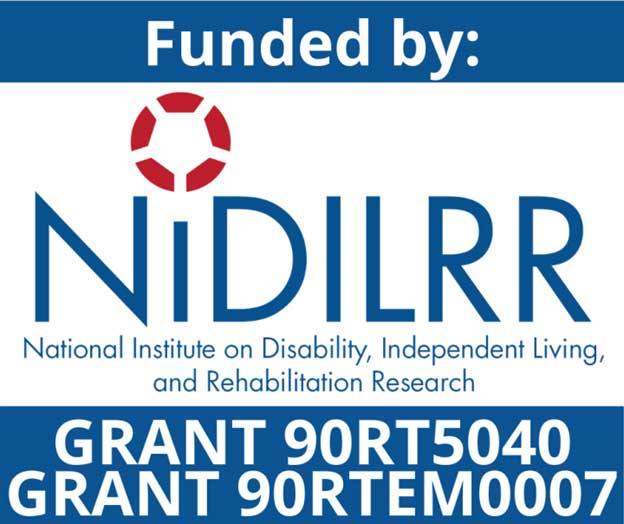If your vision is changing, there are services that can help you:
- Adjust to vision loss
- Keep or find a job
- Learn to use new communication tools or assistive technologies
- Learn to get around safely inside and outside your home
Vocational Rehabilitation
Each state has a federally funded vocational rehabilitation (VR) program to help people with disabilities (like vision loss) learn new skills and return to work. Many state VR programs have services designed for people who are blind or have low vision (B/LV). This is not welfare. It is a program to help people keep their job or find a new one and be more independent.
If you start VR services, your skills and abilities will be evaluated. Then, a VR counselor will help you make a plan to get a new job or stay at your current job. Your plan might include vocational training; learning new adaptive skills; or learning to use assistive technology, like computers with speech output or screen magnification.
After you finish rehabilitation and training, VR staff will help you look for a job. VR staff can find and work with potential employers to help them learn how workers with B/LV can do a job. VR staff will also help you get ready for job interviews. Some VR agencies have a specific staff member who helps with writing resumes, looking for jobs, and preparing for interviews.
View this list to find a VR office in your state or search the internet using the name of your state and the term “Vocational Rehabilitation Services.”
Rehabilitation Counseling Services
Rehabilitation counseling services are provided by rehabilitation counselors who help B/LV people prepare for and find a job. A rehabilitation counselor can work with you to plan for employment that fits your strengths, resources, and interests. These services go hand-in-hand with VR services.
Rehabilitation counseling services also include resources to help you reach your job goals. These resources may involve:
- Physical or mental restoration
- Educational or job training
- Computer and adaptive equipment
- Job readiness, placement, and retention services
Low Vision Services
If your vision does not get better with normal glasses or contacts, an eye doctor may refer you for a special exam called a low vision evaluation. This evaluation is different from an exam to decide if you need glasses. It focuses on functionality and using your remaining vision.
During this exam, a low vision specialist will use charts to check your visual acuity. People with the same condition and visual acuity may see differently and have different visual abilities. The low vision specialist will look for these differences and find ways to maximize your visual functioning.
You may be prescribed optical tools, like magnification or telescopic devices, or nonoptical tools, like special lighting or large print items, to make tasks like reading easier. You may also get training to use low vision devices. Some states have a bioptic driving program to let people with low vision drive using special aids and training (visit Driving with Bioptics to learn more).
A low vision exam will not return your vision to where it was before, but by using magnification tools and visual strategies, you can learn to use your remaining vision better. Some people have a big improvement, others a small one. If you think a low vision exam might help you, ask your eye doctor or VR counselor to refer you to a low vision specialist for the exam.
Low vision exams and devices can be expensive. VR may be able to help with the cost of exams and tools you need.
Orientation and Mobility Training
Orientation and mobility (O&M) skills have to do with the ability of a B/LV person to get around safely and confidently. Orientation is a person's sense of where they are in space and how a person finds their way to a destination. It includes understanding directionality (north, south, east, and west) and the details of a place. Orientation answers the questions, “Where am I?”, “Where am I going?”, and “How am I going to get there?”
Mobility is a person’s ability to move safely through an environment. People with B/LV often use human guides, dog guides, or white canes to help with mobility. Mobility answers the question, “How am I going to safely get where I want to go?”
Electronic travel aids or wayfinding tools can also help people with B/LV safely travel through complex or unfamiliar environments. These include devices like GPS systems, laser canes, and audible streetlights.
Blind or Vision Rehabilitation Services
Vision rehabilitation therapists (VRTs) help people adjust to vision loss. These specialists may also be called rehabilitation teachers, independent living instructors, or braille instructors. VRTs teach skills and assistive technology use to help people with B/LV live safe and independent lives. VRTs also work to improve job opportunities, independent living, and education for B/LV people. They work in either center- or home-based settings.
VRTs teach skills in areas like:
- Communication: braille, handwriting, recording skills, use of electronic reading systems, use of assistive technology, computer access technology
- Personal management: grooming, hygiene, organizing clothes, measuring medications, socializing skills
- Home management: organization and labeling, repair and home maintenance, budgeting, record keeping
- Daily living: cooking, cleaning, shopping, safety, money organization and management
- Leisure: hobbies, woodworking, crafts, sports
- Psychosocial aspects of B/LV: adjustment to and acceptance of vision loss
- Medical management: assessment and instruction for adaptive medical equipment, medicine identification and organization
- Basic O&M skills: sighted guide, safety techniques
To learn more about vision rehabilitation or blind services, visit the VisionAware website, which focuses on independent living for B/LV people.
